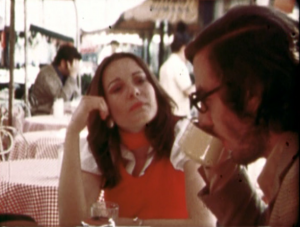
"Una cinta cargada de referencias a Jean-Luc Godard (Los Carabineros, 1963) pero sobre todo concentrada en la crítica mordaz al radicalismo de izquierda. Una vez más Marco Antonio Madrid hace el papel de protagonista, un joven de pelo largo, pantalón de mezclilla y saco, que se dedica a ligar en los cafés de la Zona Rosa adoctrinando a las mujeres. Lee a Marx después de hacer el amor, y se junta con sus amigos para brindar por "la muerte de la intelectualidad burguesa". Montero utiliza intertítulos como recurso irónico, una suerte de narrador externo que interpela la historia: "¿Qué es la intelectualidad burguesa?". La lucha revolucionaria del joven y sus amigos está teñida de sentido del humor. En una secuencia que recuerda mucho a Los Carabineros, suben al techo de una fábrica para iniciar la lucha armada (...) Por último un cartel proporciona una última burla: "Y si el sol es burgués detendremos al sol" " (Vázquez Mantecón, 2012).
"A film loaded with references to Jean-Luc Godard (The Carabineers, 1963), but above all focused on biting criticism to the radical left. Once again Marco Antonio Madrid plays the role of the lead character, a young man with long hair, jeans and coat, that dedicates his time to hook up in the coffee shops of the Zona Rosa indoctrinating women. He reads Marx after making love and he gets together with his friends to toast for the "death of the bourgeois intellectuality". Montero uses intertitles as a resource for irony, a sort of outside narrator that interpellates the story: "What is bourgeois intellectuality?". The revolutionary fight of the young man and his friends is filled with a sense of humor. In a sequence that reminds us of The Carabineers, they go to the rooftop of a factory to begin the armed fight. (...) Finally a sign shows one last derision "And if the sun is bourgeois, we will stop the sun" " (Vázquez Mantecón, 2012).
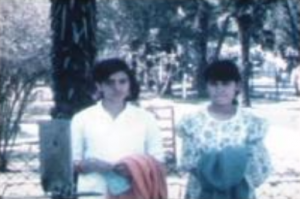
"Esta cinta se basaba en una idea de David Celestinos de enviar a diversos equipos de filmación a desarrollar historias sobre lo que ocurre un domingo en la Ciudad de México de manera simultánea. El resultado fue interesante, en la medida en la que muestra la cotidianidad dominguera de diversos personajes que provienen de distintas clases sociales: un borracho llega con su compadre a la casa de la vecindad y es recibido de mala manera por la mujer, un grupo de juniors pasa el día en Cuernavaca, un hombre solitario recorre las calles y parques del centro de la Ciudad de México, un velador se aburre en el edificio que custodia, dos sirvientas pasan el día en Chapultepec, una familia clasemediera que va a misa y a pasar un día de campo... La cinta sigue el planteamiento hecho por el neorrealismo italiano de no convocar actores profesionales para presentar historias sencillas, ligeramente dramatizadas" (Vázquez Mantecón, 2012.
"This film was based in an idea by David Celestinos of sending diverse filming crews to develop stories about what happens simultaneously on a Sunday in Mexico City. The result was interesting since it showed the Sunday everydayness of diverse characters from different social classes: a drunk man arrives at his friend's house in a poor neighborhood and is received in a bad way by a woman, a group of juniors that spend their day in Cuernavaca, a lonely man that goes through the streets and parks of Mexico City, a night watchman that is bored in the building he is in charge of, two maids that spend the day in Chapultepec, a middle class family that goes to mass and to have a picnic... The film follows the idea posed by Italian Neorealism of not using professional actors to present simple stories, slightly staged" (Vázquez Mantecón, 2012).
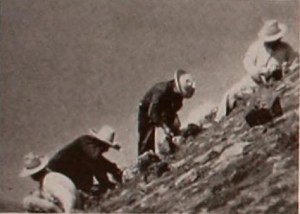
"The immaculate camera work, incisive editing and attractive titling of Frank E. Gunnell have flowered into a new and superior beauty in Down Mexico Way. Here, in two full reels which seem like less, are all the standard Mexican Meccas — the capital city, the pyramids of Teotihuacan, Cuernavaca and the rest — each suavely sequenced and beautifully filmed. Added to these is a wealth of human interest, in smoothly planned records of such odd Mexican folklore as the self threaded needle cut from a maguey cactus, or the red dye concealed in the silvery cochineal wood louse. Mr. Gunnell's most superb triumphs, however, are in his moody and magnificent studies of Xochimilco and Taxco, Mexican communities which have beckoned to countless movie makers, but which only a few have answered with genuine eloquence and distinction." Movie Makers, Dec. 1941, 563-564.
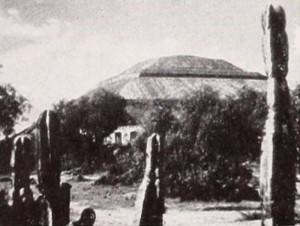
"Down Mexico Way, by Lester F. Shaal. is a pleasing combination of travel, education and simple, stirring beauty. Beginning at the Providence (R. I.) railway station (the producer's home city), the film takes us swiftly by train to Mexico, D. F., the country's capital. After a tour of that metropolis, one visits in turn such popular tourist meccas as Xochimilco, San Juan Teotihuacan, Cuernavaca, Toluca, Taxco and others. An attractive map of Mexico, in color, introduces these several journeys and makes clear the geographical relations of the different towns. Mr. Shaal's camera work is tripod steady throughout, his compositions are pleasing and his musical scoring is an effective supplement. Of outstanding beauty are his sequences on golden, sunny Taxco and of the ancient, so often cloud shrouded, twin volcanos." Movie Makers, Dec. 1944, 495-496.
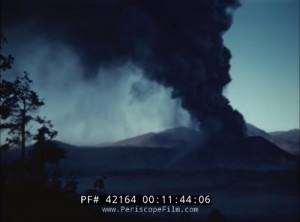
"This extraordinary silent 16mm home movie was shot by Dr. Harold L. Thompson, and shows the eruption of the Paricutin volcano. It likely dates towards the end of the volcanic eruption in the early 1950s." Periscope Film.
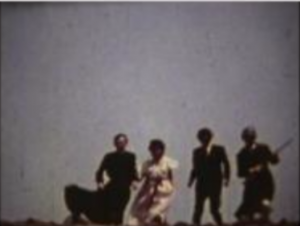
"Una historia sobre el acoso sufrido por la juventud por parte del mundo de los adultos. La posición alternativa del grupo [de realizadores] se hacía explícita desde las primeras tomas, en donde los créditos aparecían escritos en las paredes de una casa en ruinas, omitiendo los apellidos y dejando solo los nombres de pila de quienes participaron" (Vázquez Mantecón, 2012).
"A story about the harassment suffered by the youth from the adult world. The alternative position of the group [of filmmakers] was made evident from the first shots, where credits appeared written on the walls of a house in ruins, omitting last names and leaving only the first names of the participants" (Vázquez Mantecón, 2012).
"A scientific expedition to Mexico for a study of the animals, reptiles and birds. Our visit for the most part is in the rural or wilderness areas but we do get into the market place and we see some of the ancient ruins. A pictorial review of a great many of species of wild life which we rarely see as many of us are afraid to visit the habitat of those creatures. The close-up photography puts the small creatures almost on our noses" PSA Journal, Nov. 1959, 48.
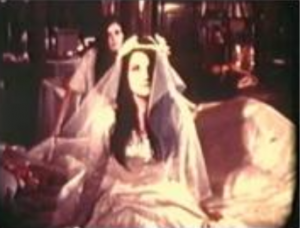
"Celestinos filmó la cinta en una vieja casa de Chimalistac, al sur de la Ciudad de México. Según la historia en ella habitan dos hermanas que viven un encierro real y metafórico a causa de su sexualidad reprimida. Las primeras imágenes de la película muestran a una de ellas vestida de novia, mientras que otra lleva la cola del vestido. La escena da pie a un erotismo doloroso: una de ellas se acaricia para que la cámara muestre en close up sus lágrimas. Un flash back nos muestra la causa: el momento de su infancia en que una monja de visita en la casa le dio manotazos por haberle mostrado una imagen de una mujer desnuda que encontró por casualidad. El personaje busca liberación. (...) La otra hermana también busca salir de la casa (emblema del ámbito doméstico familiar), y encontrar su libertad sexual" (Vázquez Mantecón, 2012)
"Celestinos filmed the tape in an old house in Chimalistac, south of Mexico City. According to the story, the house is inhabited by two sisters that live in a real and metaphorical confinement because of their repressed sexuality. The first images of the film show one of them dressed as a bride, while the other carries the tail of the dress. The scene is followed by a painful erotism: one of the caresses herself to make the camera show her tears in close up. A flash back shows the cause: the moment of her childhood when a nun hits her hands because she showed her a picture of a naked woman that she found by chance. The character seeks liberation. (...) The other sister is also looking forward to leave the house (emblem of the familial domestic scope), and to find her sexual freedom" (Vázquez Mantecón, 2012)
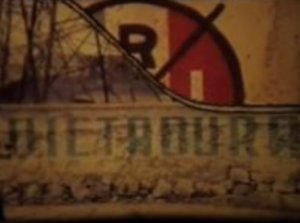
"La película realizaba un montaje lúdico al yuxtaponer los mensajes políticos oficiales escritos en las bardas de la ciudad con imágenes o textos que los ironizaban o alteraban su sentido. El título viene de un juego de palabras con el fraseo de las sílabas "Mé-xi-co" / jí-ca-ma", que solían usarse entonces como porra en los partidos de fútbol de la selección nacional" (Vázquez Mantecón, 2012).
"The movie had a playful montage by juxtaposing official political messages written in walls around the city with images or text that ironized them or altered their meaning. The title comes from a word game that played with the phrasing of the syllables "Me-xi-co / ji-ca-ma", a popular chant during the national team soccer games of the time" (Vázquez Mantecón, 2012).
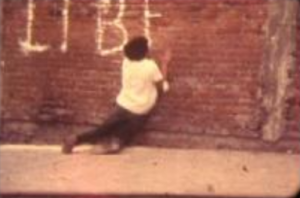
"El relato iniciaba con la presentación de un grupo de jóvenes que corren de manera desesperada por las calles de la ciudad, presumiblemente perseguidos por la policía. Inexplicablemente, dada la urgencia de la huída, uno se detiene a escribir en una barda la palabra "Libertad". No lo consigue, porque una bala lo derrumba cuando apenas va en "Libe...". (de ahí el título de la película). [...] La película apenas muestra una esperanza posible en la lucha por la libertad. Después del acoso y el acecho, todos los jóvenes que han protagonizado la historia mueren por una bala anónima de una fuerza represiva que no alcanza a tener un rostro definido" (Vázquez Mantecón, 2012).
"The story began with the presentation of a group of young people that run desperately throughout the city streets, presumably they are being chased by the police. Inexplicably, given the urgency of the escape, one of them stops to write the word "Freedom" on a wall. He fails, because a bullet overthrows him when he has barely written "Freed.." (hence the title of the film). [...] The film barely shows hope for the struggle for freedom. After the harassment and the siege, all the young people that starred the film are murdered by an anonymous bullet of a repressive force that does not have a defined face" (Vázquez Mantecón, 2012).
Total Pages: 5